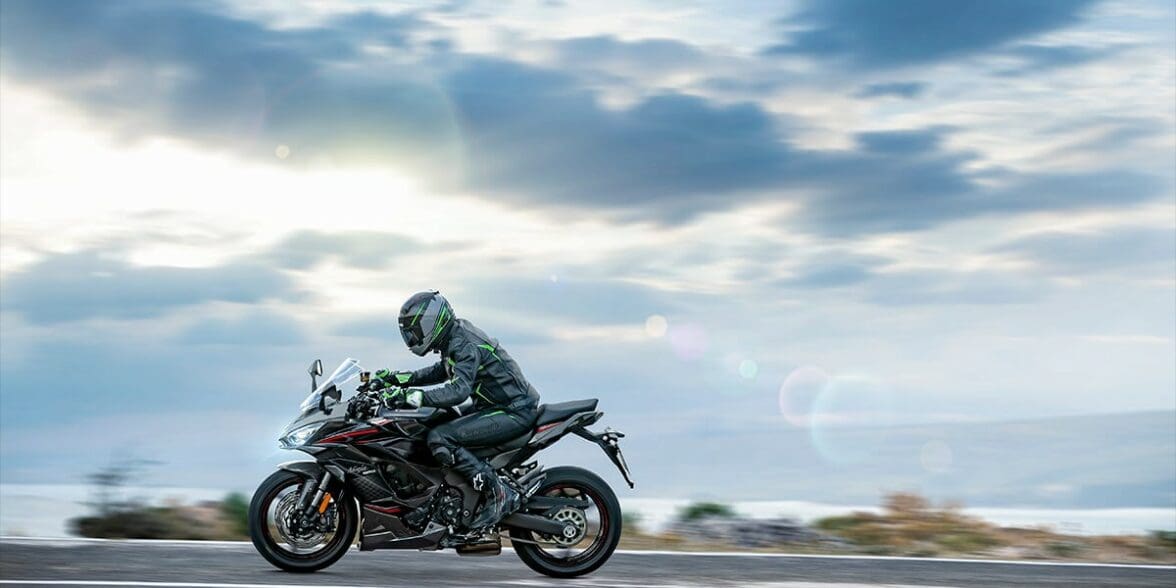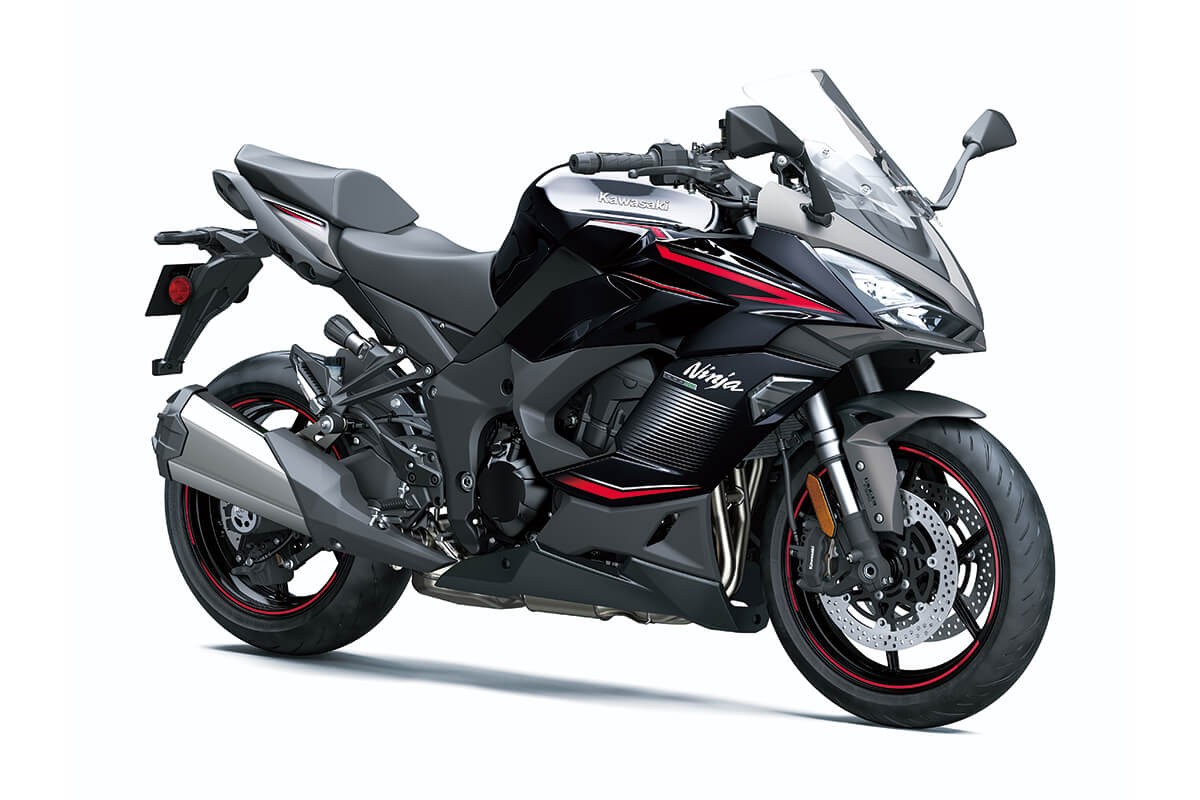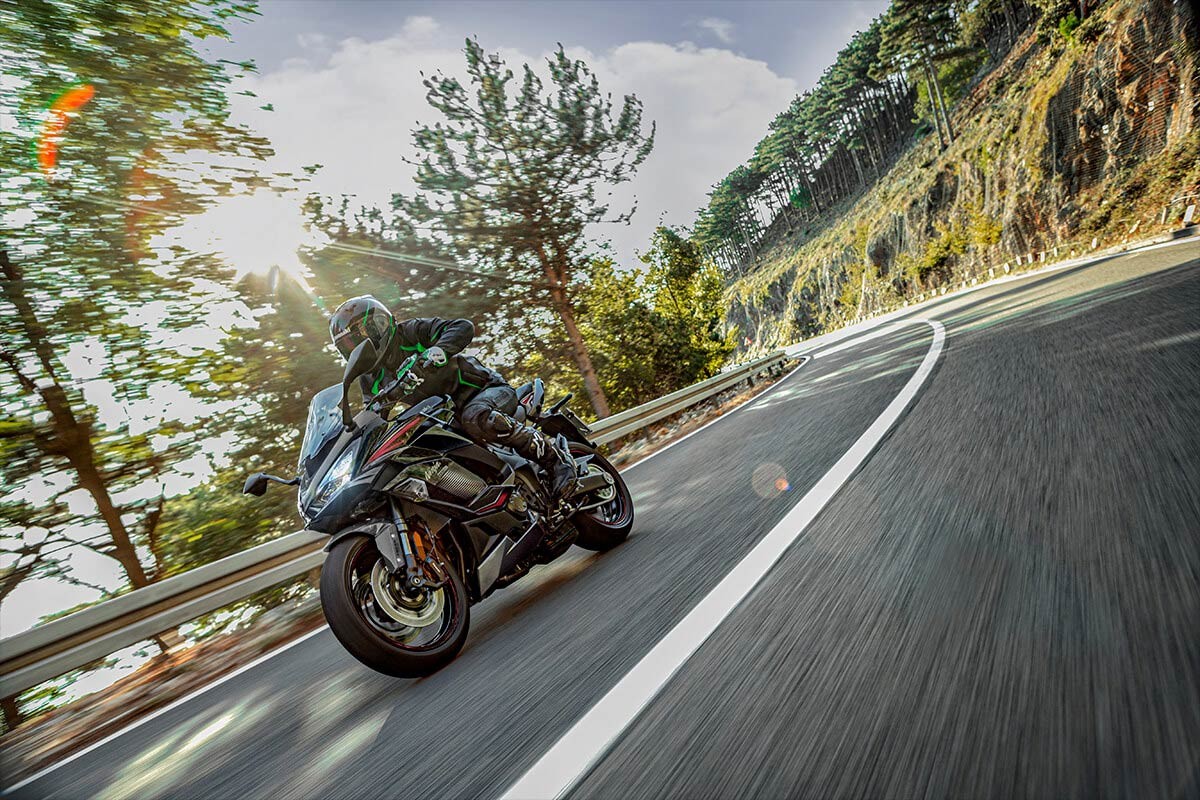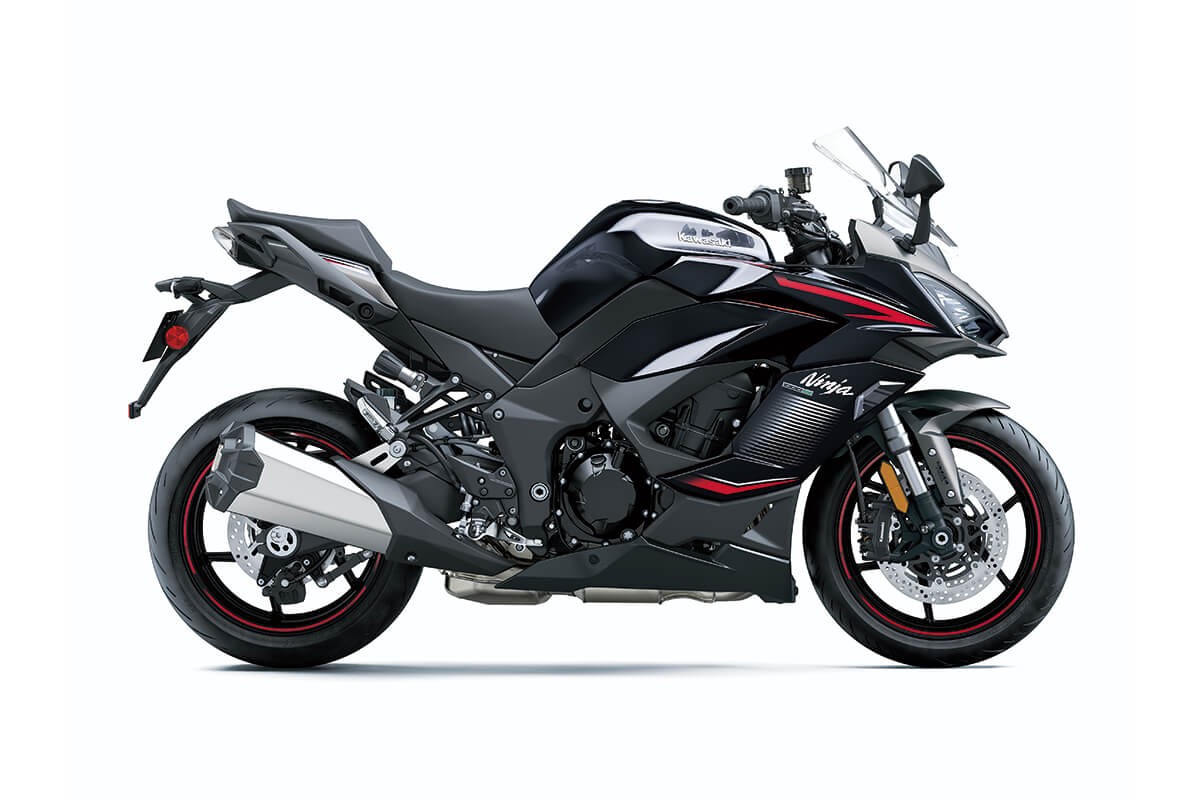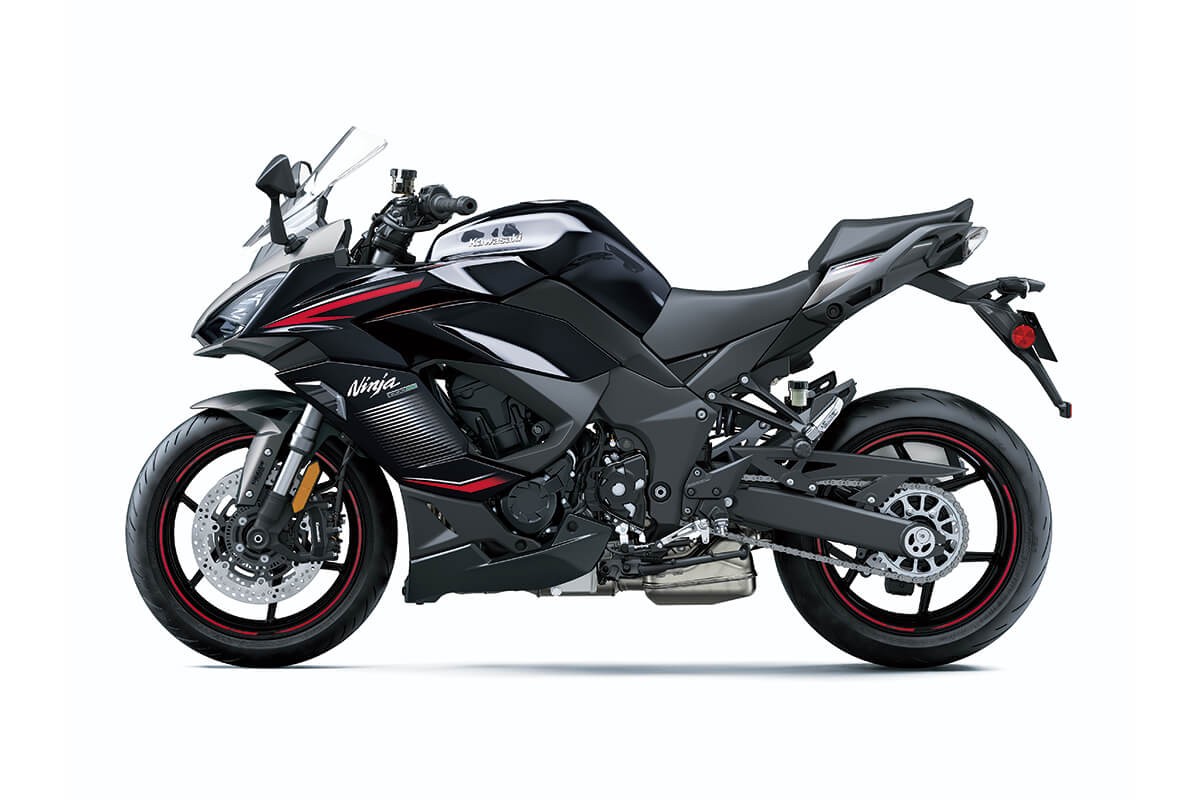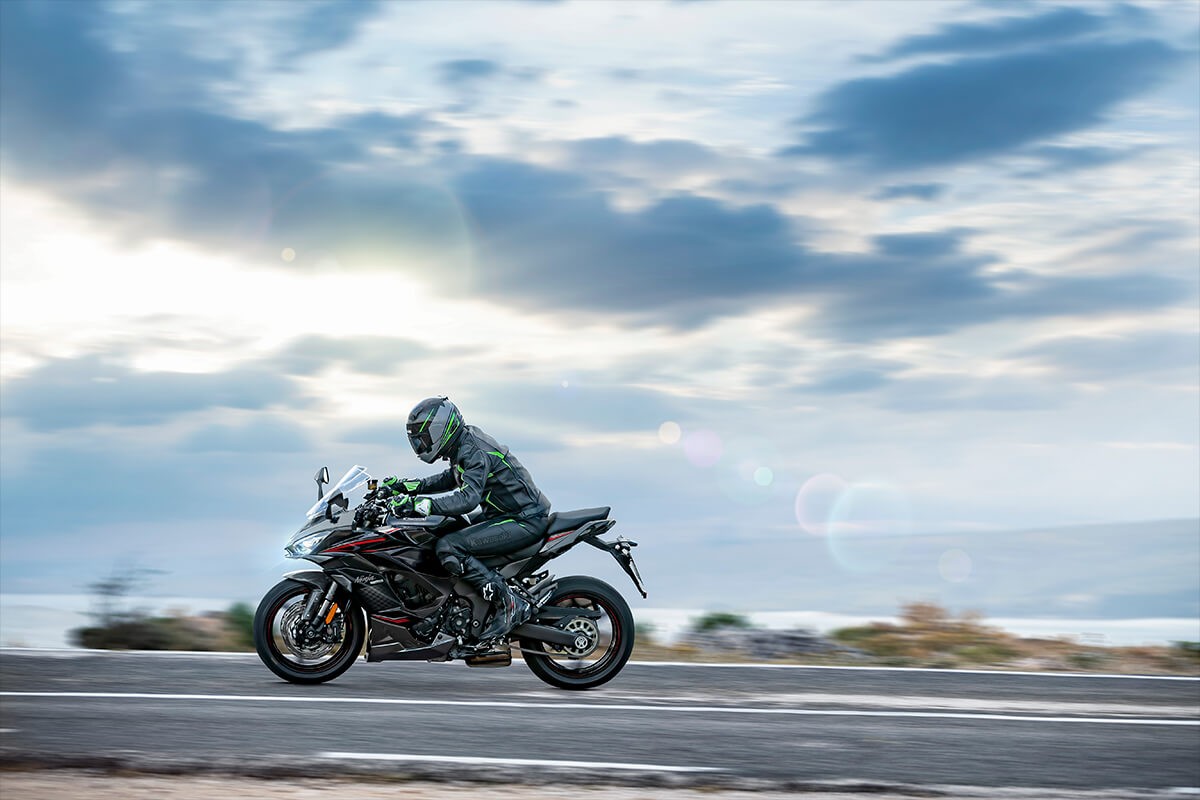The 2022 Kawasaki Ninja 1000SX: That’s a Lotta Ninja
Contents
Sport touring capabilities with the features of a superbike? It’s no joke—it’s the Kawasaki Ninja 1000SX, which you’ll be just as happy riding two-up with a partner on a cross country trip as you will be tearing it around your local track like a demon.
Kawasaki has always given its sport bikes a lot of grunt, and the Ninja 1000SX is no exception. It features a 1,043cc in-line four engine that produces 124.3 hp @ 9,500 rpm and 75.4 lb-ft of torque @ 8,000 rpm. For the 2022 model year, this bike also comes with features designed to make long-distance touring easier—like a four-into-one exhaust, a more comfortable seat, and an adjusted windscreen.
Major Japanese motorcycle brands make so many track monsters that it’s sometimes easy to overlook a road-friendly sport bike like this one—but that would be a mistake. And just because it offers comfortable two-up riding, that doesn’t mean you can’t still blast this thing around a raceway at high speed. The presence of KCMF (Kawasaki Cornering Management Function) suggests Kawasaki absolutely wants you to do just that.
It has some competition from the likes of the BMW R 1250 RS and the Yamaha Tracer 9 GT, but this bike fills a very unique niche in Kawasaki’s 2022 motorcycle lineup and should have no trouble holding its own with liter bikes from rival brands.
The bike is available in two color options — Metallic Diablo Black/Pearl Robotic White and Emerald Blazed Green/Metallic Diablo Black/Metallic Graphite Gray.
The 2022 Kawasaki Ninja 1000SX starts at $12,899 USD / $15,099 CAD.
On this page: we’ve curated specs, features, news, photos/videos, etc. so you can read up on the new 2022 Kawasaki Ninja 1000SX in one place.
Model Overview
General Info
- Price: $12,899 USD / $15,099 CAD
- Key Features:
- Electronic cruise control & economic riding indicator
- Kawasaki Cornering Management Function & Kawasaki Traction Control
- Multiple power modes
- IMU-enhanced chassis orientation awareness & horizontal back-link rear suspension
Main Specs
- Engine: 1,043cc in-line four
- Power: 124.3 hp @ 9,500 rpm
- Torque: 75.4 lb-ft of torque @ 8,000 rpm
- Curb Weight: 514 lbs (233 kg)
- Seat Height: 32.3 inches (820mm)
Competitors
2022 Kawasaki Ninja 1000SX Specifications
ENGINE |
||
| Engine | 1,043cc, 4-stroke, In-Line Four, DOHC, 16-valve, liquid-cooled | |
| Power | 124.3 hp | |
| Bore x Stroke | 77.0 x 56.0mm | |
| Compression Ratio |
11.8:1
|
|
| Fuel System | DFI® w/38mm Keihin throttle bodies (4) and oval sub-throttles | |
| Starter | Electric | |
| Electronic Rider Aids | Kawasaki TRaction Control (KTRC), Kawasaki Intelligent anti-lock Brake System (KIBS), Power Mode, Kawasaki Corner Management Function (KCMF), Kawasaki Quick Shifter (KQS) (Up-Down) | |
DRIVETRAIN |
||
| Clutch | ||
| Transmission | 6-speed, Manual, Return Shift | |
| Final Drive | Sealed chain | |
CHASSIS |
||
| Suspension Front | 41mm inverted cartridge fork with stepless compression and rebound damping, adjustable spring preload/4.7 in | |
| Suspension Rear | Horizontal back-link with stepless rebound damping, remotely adjustable spring preload/5.7 in | |
| Brakes Front | Dual 300mm discs with radial-mount 4-piston monobloc calipers and KIBS ABS | |
| Brakes Rear |
Single 250mm disc with single-piston caliper and KIBS ABS
|
|
| Tires Front | 120/70 ZR17 | |
| Tires Rear | 190/50 ZR17 | |
| Fuel Tank Capacity | 5.0 gal | |
| Color |
Metallic Matte Graphenesteel Gray/Metallic Diablo Black
|
|
ELECTRICAL |
||
| Ignition | TCBI with digital advance | |
| Spark Plugs | ||
| Headlight | LED | |
| Tail Light | LED | |
DIMENSIONS |
||
| Overall Length | 82.7 in | |
| Overall Width | 32.5 in | |
| Overall Height | 46.9 / 48.2 in | |
| Wheelbase | 56.7 in | |
| Ground Clearance | 5.3 in | |
| Seat Height | 32.3 in | |
| Curb Weight | 513.8 lb* | |
WARRANTY |
||
| Warranty | 12 Months | |
| Kawasaki Protection Plus | 12, 24, or 36 months | |
2022 Kawasaki Ninja 1000SX Features
Assist & Slipper Clutch
Under normal operation, the assist cam functions as a self-servo mechanism, pulling the clutch hub and operating plate together to compress the clutch plates. This allows the total clutch spring load to be reduced, resulting in a lighter clutch lever feel when operating the clutch.
When excessive engine braking occurs – as a result of quick downshifts (or an accidental downshift) – the slipper cam comes into play, forcing the clutch hub and operating plate apart. This relieves pressure on the clutch plates to reduce back-torque and helps prevent the rear tire from hopping and skidding. This race-style function is particularly useful when sport or track riding.
Economical Riding Indicator
While effective vehicle speed and engine speed may vary by model, paying attention to conditions that cause the “ECO” mark to appear can help riders improve their fuel efficiency – a handy way to increase cruising range. Further, keeping fuel consumption low also helps minimize negative impact on the environment.
Electronic Cruise Control
Electronic Throttle Valves
Electronic throttle valves also enable more precise control of electronic engine management systems like S-KTRC and KTRC, and allow the implementation of electronic systems like KLCM, Kawasaki Engine Brake Control, and Electronic Cruise Control.
KCMF (Kawasaki Cornering Management Function)
KTRC (Kawasaki Traction Control)
Less intrusive modes maintain optimum traction during cornering. Designed with sport riding in mind, they facilitate acceleration out of corners by maximizing forward drive from the rear wheel. And because Kawasaki’s sophisticated software bases its dynamic analysis on the chassis’ orientation relative to the track surface (rather than relative to a horizontal plane), it is able to take into account corner camber, gradient, etc., and adapt accordingly.
In the more intrusive modes (and for some models, in any mode), when excessive wheel spin is detected, engine output is reduced to allow grip to be regained, effectively enabling riders to negotiate both short, slippery patches (train tracks or manhole covers) and extended stretches of bad roads (wet pavement, cobblestone, gravel) with confidence.
Power Modes
Smartphone Connectivity
ABS (Anti-lock Brake System)
Horizontal Back-link Rear Suspension
2022 Kawasaki Ninja 1000SX Photos
2022 Kawasaki Ninja 1000SX Videos
Comparing the 2022 Kawasaki Ninja 1000 SX to the 2022 Suzuki GSX S1000 GT. First ride review.
2022 Kawasaki Ninja 1000 SX in-depth walkaround
Links
Kawasaki Official Websites


